Abstract
Background
Labor pain is one of the most severe pains, which most of women experience. By using novel supportive methods, the labor pain can be reduced, which makes this event pleasant and delightful. Several original studies have been conducted in regard to the effect of lavender on reducing labor pain, whose results are controversial. One of the applications of meta-analysis studies is to respond to these hypotheses and remove controversies; therefore, this study aimed to determine the effect of lavender on labor pain in Iran by using meta-analysis.
Methods
In this study, to find published articles electronically from 2006 to 2019, the published articles in national and international databases of SID, MagIran, IranMedex, IranDoc, Google Scholar, Cochrane Library, Embase, ScienceDirect, Scopus, PubMed, and Web of Science (ISI) were used. Heterogenic index between studies was determined by Cochrane test (Q)c and I2. Due to heterogeneity, the random effects model was used to estimate standardize difference of the mean score of lavender test in order to assess the labor pain between intervention and control group.
Results
In this meta-analysis and systematic review, finally 13 eligible articles met the inclusion criteria of the study. The sample size from original studies enrolled in the meta-analysis entered in the intervention group was 794 individuals and in the control group was 795 individuals. Mean score for pain in the control group was 7.2 ± 0.42 and in the intervention group was 5.4 ± 0.58 and this difference was statistically significant (p ≤ 0.001).
Conclusion
The results of this study showed that lavender can reduce labor pain, which can be considered by health policy makers and gynecologists.
1. Background
Although labor is a natural phenomenon, its accompanied pain is severe in more than half of the pregnant women. Most of the women tend to avoid invasive and pharmaceutical methods in management of labor pain, and this issue may increase their tendency to use nonpharmaceutical pain relief methods [1].
Labor pain is one of the most severe pains, which most of women experience. Using novel supportive methods can reduce labor pain and make this event pleasant and delightful [2].
Data from one study showed that perineal massage during the second phase of labor is an appropriate strategy to reduce the number of episiotomy cases and the severity of perineal rupture, possibly due to increased blood flow, elasticity, and perineal softness due to massage [3]. Nonpharmaceutical approach on pain consists of wide spectrum techniques which not only reduce the physical sensation of pain, but also prevent mental suffering resulted from pain care [4].
Aromatherapy using approach is considered for pain today. Controlled use of essence oils for treatment is named aromatherapy. Aromatherapy approach is one of the methods of substitutive medicine in many countries [5], which is applied through various methods such as massage, inhalation, bath, and compress [6]. Massage by midwife results in significant reduction in anxiety and increase in mental support for women in labor [7]. Massage therapy by lavender oil is an effective intervention in reducing the severity of pain in labor that is preferred rather than many nonpharmaceutical methods [8].
Cesarean section is a common surgery around the world, and its prevalence is about 50% of all the labors in Iran [9], and as other surgery procedures, the subsequent pain is reported repeatedly. Controlling of this pain is important for mother in regard to caring for the infant and breastfeeding [10]. Insufficient pain control after cesarean section increases the complications of wounds, infection, and the costs of care process, so that the hospital costs and length of hospital stay are, respectively, 76% and 77% higher than vaginal delivery [11].
Massage is a therapeutic and complementary method applied for various conditions and is of high interest among individuals [8]. Oily essences show the same potency as medications and can be used in a similar way as them, and until more clinical trials are conducted in this field, they should be used by midwives cautiously in the lowest dose and frequency [4]. Studies showed that aromatherapy by using oily essences extracted from aromatic herbs [12] such as lavender, jasmine, and geranium through massage in labor, is effective on mothers' mind [13].
Even when oily essences such as lavender are released in the air and breathed by lungs through uterine contractions, they can produce endorphins in the body to reduce natural pain. In addition, using lavender and Salvia officinalis as cold compress on the forehead can help with fatigue and recovery after pain [14].
Lavender, which has long been used in traditional medicine, belongs to family Lamiaceae, and it is also a herbaceous, aromatic, and evergreen herb with a bitter taste and contains volatile oily essence and widely used in aromatherapy [15]. Lavender aroma inhalation decreases anxiety during labor and cortisol secretion and increases serotonin secretion by gastrointestinal tract [16].
In animal studies, lavender oily essence had sedative [17] and analgesic [18] effects. Lavender contains linalool alcohol ketone esterzoaldehyde. Ketones in lavender effectively reduce pain and inflammatory and help falling asleep [18]. Esters prevent muscular spasm, reducing stress and depression [19, 20]. Several original studies in regard to the effect of lavender on reduction in labor pain have been performed, and the results are controversial. One of the applications of meta-analysis studies is clarifying these hypotheses and eliminating controversies. Therefore, this study aimed to determine the effect of lavender on the reduction of labor pain in Iran by using meta-analysis.
2. Methods
2.1. Literature Review Method
In this study, searching for the Persian databases of SID, MagIran, IranMedex, and IranDoc and international databases of Google Scholar, Cochrane Library, Embase, ScienceDirect, Scopus, PubMed, and Web of Science (ISI) was done in order to find relevant citations from 2006 to 2019. The reference list of all the relevant articles and reports which are found in electronic search was assessed manually to find other probable citations. In case of unavailable articles, a contact was performed by e-mail with authors, and at least a 2-week period was allocated to wait for their response.
2.2. Inclusion Criteria
Criteria for Article Selection. Articles with the following characteristics were selected for the meta-analysis: (1) original articles, (2) clinical trials (RCT), (3) availability of full texts, and (4) the studies that investigated the association between lavender and reduction of labor pain.
2.3. Exclusion Criteria
The articles were performed in review format, or their sample was not selected from the women in labor, and also replicated studies with previous data were excluded.
Used keywords for literature review were selected through Medical Subject Heading (MESH).
Persian keywords were lavender, pain, labor, and cesarean section, and English keywords were lavender, Pain, Giving Birth, Childbirth, Cesarean, Hysterotomy, and Iran.
((((((((((((((lavender[Title/Abstract]) AND (pain[Title/Abstract])) OR (Ache[Title/Abstract])) OR (Suffering[Title/Abstract])) AND (labor pain[Title/Abstract])) OR (Obstetric Pain[Title/Abstract])) OR (Labor, Obstetric[Title/Abstract])) AND (Cesarean Section[Title/Abstract])) OR (Post cesarean Section[Title/Abstract])) OR (Abdominal Delivery[Title/Abstract])) OR (C-Section (OB)[Title/Abstract])) AND (Childbirth[Title/Abstract])) OR (Parturition[Title/Abstract])) OR (Birth[Title/Abstract])) AND (Hysterotomy[Title/Abstract])) OR (Uterus/surgery[Title/Abstract])))))))))))))
In the group of oily essence of lavender, the essence manufactured by Barij Essence Company belonged to Stoechas species and was made from unopened flowers through distillation with 1.5% concentration, and its carrier is olive oil; it is guided as cold incense and provided to the mothers by mask. The mothers were asked to inhale through cold incense mask during contraction and pain. Women in the group of massage with lavender oil in each step underwent massage with inhalation of 2 ml lavender oil. For this purpose, the severity of pain was measured by using pain standard assessment scale that is a visual analog scale (VAS) for pain [21]. All the articles had control group (not participated in intervention). Both intervention and control groups were provided with the same standard clinical care.
2.4. Qualitative Assessment of the Articles
The quality of articles was assessed based on the selected items and related to CONSORT list which have been pointed out in previous studies. The articles pointing to 6-7 items of criteria were considered as high-quality articles, those pointing to 2 items and those that did not point to more than 2 of 7 items were considered, respectively, as articles with medium-level and low-level methodological quality [22]. In the current study, 13 articles were entered in systematic review and meta-analysis as high- and medium-quality articles, and 6 low-quality articles were omitted (Table 1).
Table 1.
Evaluation of quality of quantitative studies using STROBE tool (N = 13).
| Row | Author(s) and year of publication | Introduction | Methods | Results | Discussion and conclusion | Score | |||||||||||||||||
|---|---|---|---|---|---|---|---|---|---|---|---|---|---|---|---|---|---|---|---|---|---|---|---|
| Title and abstract | Introduction | Study method | Performing environment | Contributors | Variables | Data source and measurement method | Bias | Sample size | Quantitative variables | Statistical analysis methods | Descriptive data | Participants' reports | Report the original data | Main results of the study | Other analyzes | Report key results | Limitations | Interpretation of results | Generalization | Budget and financial support | |||
| 1 | Vakilian et al., 2012 [23] | + | + | + | + | + | + | + + |
− | − | + + |
+ | + | + | + | + | − | + | + | + | − | − | Medium |
| 2 | Alavi et al., 2010 [24] | + | + | + | + | + | + | + + |
− | − | + + |
+ | + | + + |
+ + |
+ | − | + | − | + + |
− | − | High |
| 3 | Seraji and Vakilian, 2011 [25] | + | + | + | + | + | + | + + |
− | + | + + |
+ | + | + | + | + | + | + | + | + + |
− | − | High |
| 4 | Leghaei and Hosseini, 2018 [26] | + | + | + | + | + + |
+ + |
+ + |
− | + | + + |
+ | + | + + |
+ | + + |
+ | + | + | + + |
− | − | High |
| 5 | Hosseini et al., 2016 [27] | + | + | + | + | + | + | + + |
− | + | + + |
+ | + | + + |
+ | + | + | + | + | + + |
− | − | High |
| 6 | Nikbakht et al., 2014 [28] | + | + | + | + | + | + | + + |
− | + | + + |
+ | + | + | + | + | + | + | + | + + |
− | − | High |
| 7 | Nehbandanii et al., 2018 [29] | + | + | + | + | + | + | + + |
− | + | + + |
+ | + | + | + | + | + | + | + | + + |
− | − | High |
| 8 | Sobhani et al., 2006 [30] | + | + | + | + | + | + | + + |
− | + | + | + | + | + | + | + | + | + | + | + |
− | − | Medium |
| 9 | Khani et al., 2013 [31] | + | + | + | + | + | + | + |
− | + | + | + | + | + | + | + | + | + | + | + |
− | − | Medium |
| 10 | Houshyar et al., 2015 [32] | + | + | + | + | + | + | + + |
− | + | + | + | + | + | + | + | + | + | + | + | − | − | Medium |
| 11 | Hadi and Hanid, 2011 [33] | + | + | + | + | + | + | + | − | + | + | + | + | + | + | + | + | + | + | + | − | − | Medium |
| 12 | Yazdkhasti and Pirak, 2016 [34] | + | + | + | + | + | + | + |
− | + | + | + | + | + | + | + | + | + | + | + | − | − | Medium |
| 13 | Olapour et al., 2013 [35] | + | + | + | + | + | + | + | − | − | + | + | + | + | + | + | + | + | + | + | − | − | Medium |
2.5. Data Extraction
All the finalized articles entered the meta-analysis were extracted by a preprepared checklist.
The checklist consisted of article title, first author name, publication year, study location, the sample size of intervention and control group, mean sample of intervention and control group, standard deviation of intervention and control group, and the rate of probability.
2.6. Statistical Analysis
Since the investigated index was the effect of lavender on labor pain, to combine the results of various studies, frequency and index of standardized mean difference in each study were used. To assess the homogeneity between studies, I2 index was used, and due to heterogeneity of the studies, random effects model was used in order to combine studies and perform meta-analysis. When the I2 index is less than 25%, it is known as low heterogeneity, and when I2 index is between 25 and 75%, it is known as medium heterogeneity and I2 more than 75% considered as high heterogeneity. P value less than 0.05 was considered as significance level. Also, funnel chart and Egger's test were used to assess publication bias.
3. Results
In this study, all the performed researches in regard to the effect of lavender on reduction of labor pain in Iran without time limitation and based on PRISMA guideline were assessed systematically (Figure 1).
Figure 1.
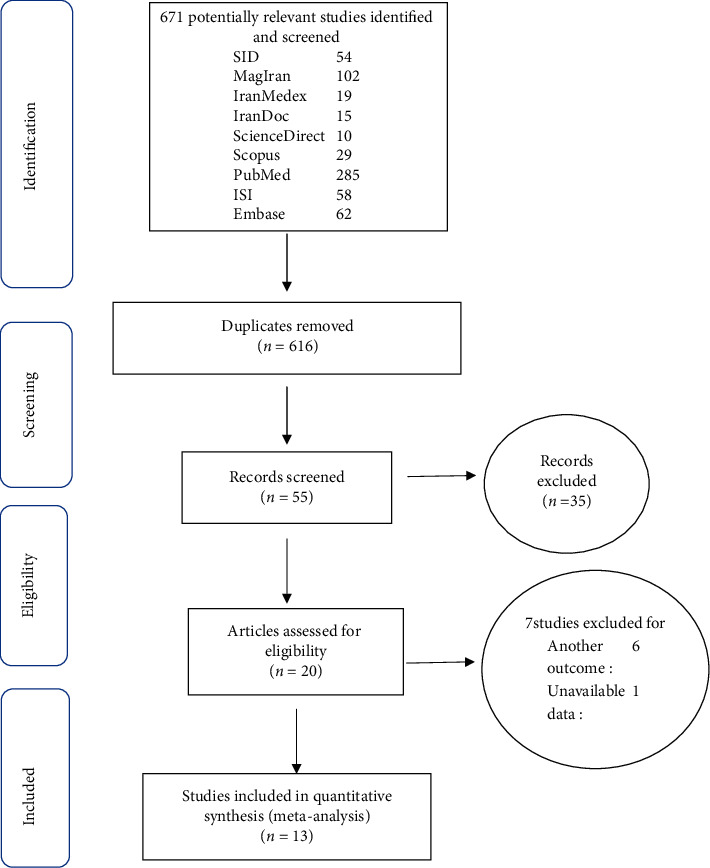
Flow diagram of study selection.
In the primary search, 671 articles were identified, and finally 13 articles published between years of 2006 and September 2019 were entered for the final analysis (Table 2). The total sample size was 1589 individuals (795 individuals at control group and 794 individuals at intervention group). The characteristics of entered studies into systematic review were shown in Table 2.
Table 2.
Specifications of studies entered into the meta-analysis.
| Author, year, reference | Country | Sample size control group | Sample size intervention group | Mean ± SD group intervention | Mean ± SD group control | P value |
|---|---|---|---|---|---|---|
| Vakilian, et al., 2012, [23] | Arak | 60 | 60 | 6.80 ± 1.73 | 7.11 ± 1.26 | 0.27 |
| Alavi, et al. 2010, [24] | Shiraz | 80 | 80 | 6.60 ± 2.20 | 7.80 ± 1.90 | ≤0.001 |
| Seraji and Vakilian, 2011, [25] | Arak | 60 | 60 | 6.85 ± 1.65 | 7.14 ± 1.30 | 0.28 |
| Leghaei and Hosseini, 2018, [26] | Shiraz | 20 | 20 | 2.92 ± 1.29 | 7.54 ± 0.65 | ≤0.001 |
| Hosseini, et al., 2016, [27] | Shiraz | 15 | 15 | 3.23 ± 0.84 | 4.70 ± 0.46 | ≤0.001 |
| Nikbakht, et al., 2014, [28] | Mashhad | 20 | 20 | 5.95 ± 1.39 | 9.65 ± 0.58 | ≤0.001 |
| Nehbandanii et al., 2018, [29] | Zabol | 30 | 30 | 7.70 ± 1.20 | 9.05 ± 0.99 | ≤0.001 |
| Sobhani, et al., 2006, [30] | Gilan | 240 | 240 | 6.14 ± 0.59 | 7.85 ± 0.32 | ≤0.001 |
| Khani, et al. 2013, [31] | Birjand | 30 | 30 | 4.78 ± 1.50 | 6.14 ± 1.52 | ≤0.001 |
| Houshyar, et al., 2015, [32] | Kerman | 50 | 50 | 6.02 ± 0.94 | 7.75 ± 0.97 | ≤0.001 |
| Hadi and Hanid, 2011, [33] | Tabriz | 100 | 100 | 1.20 ± 0.87 | 4.23 ± 0.95 | 0.12 |
| Yazdkhasti and Pirak, 2016, [34] | Tehran | 60 | 59 | 6.90 ± 1.70 | 8.50 ± 1.30 | ≤0.001 |
| Olapour, et al., 2013, [35] | Ahvaz | 30 | 30 | 5.58 ± 0.48 | 6.98 ± 0.62 | ≤0.001 |
All the studies were clinical trials. Out of 13 articles, 7 articles were published in Persian language and 6 articles were published in English language (Table 2).
The obtained results from meta-analysis showed that heterogeneity existed between studies; this value for control group was I2 = 99.5 and for intervention group was I2 = 99.6; thus, for combining the studies and final estimation of results, random method was used. For determination of publication bias in studies, Egger's test was used. Based on the results from Egger's test, publication bias was not found in studies in intervention group (p = 0.733) (Figure 2) and control group (p = 0.333) (Figure 3).
Figure 2.
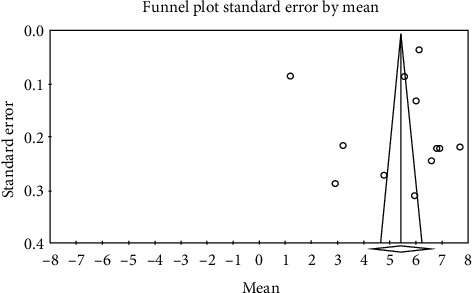
Funnel plot obtained from studies entered into the meta-analysis by using standardized mean difference index (intervention).
Figure 3.
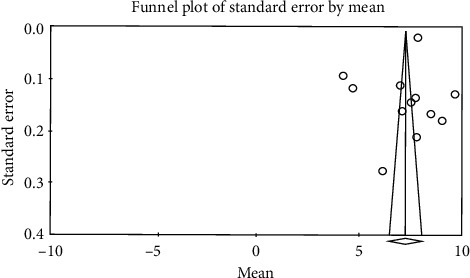
Funnel plot obtained from studies entered into the meta-analysis by using standardized mean difference index (control).
The scale obtained in the studies reviewed in the systematic review include the mean and standard error of the Visual Analog Scale; based on the results obtained from meta-analysis, total mean standard error in intervention group was 5.4 ± 0.58 (Figure 4) and total mean standard error in control group was 7.2 ± 0.42 (Figure 5). This difference was statistically significant (p ≤ 0.001) which shows that lavender reduces the labor pain. In the forest plot, mean and standard error and confidence interval of 95% in each study and also final estimation of index obtained from combination of studies were shown.
Figure 4.
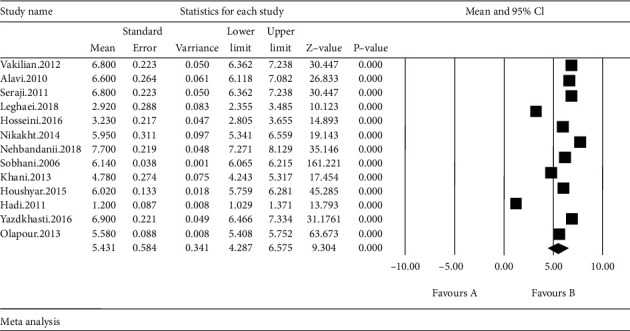
Forest plot obtained by studies entered into the meta-analysis by using standardized mean difference index (intervention).
Figure 5.
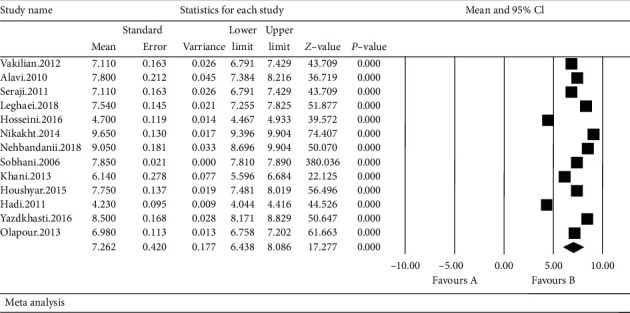
Forest plot obtained by studies entered into the meta-analysis by using standardized mean difference index (control).
In this chart, weight of each study in final combined value is shown, at which the size of each square is equal to the weight the study implemented in the meta-analysis. Horizontal line of each square shows confidence interval of 95% (Figures 4 and 5).
By using metaregression based on intervention and control groups, the year of performing study (p ≤ 0.001) and sample size (p ≤ 0.001) (Figures 6–9) with total mean of control and intervention group were assessed, at which there was a significant difference between total mean of intervention and control group; by increasing the sample size in both intervention and control groups, total mean increases (Figures 6 and 7) and by increasing the year of publication in both control and intervention groups, the total mean decreases (Figures 8 and 9).
Figure 6.
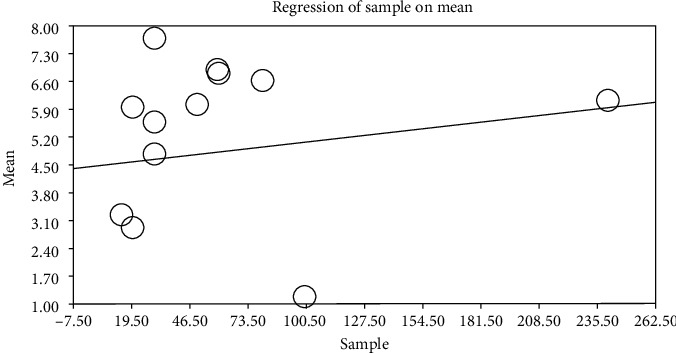
Metaregression of association between sample size and entered studies in meta-analysis by using total mean index (intervention).
Figure 7.
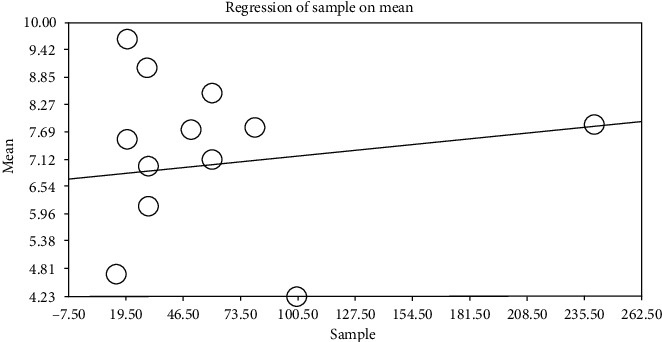
Metaregression of association between sample size and entered studies into meta-analysis by using total mean index (control).
Figure 8.
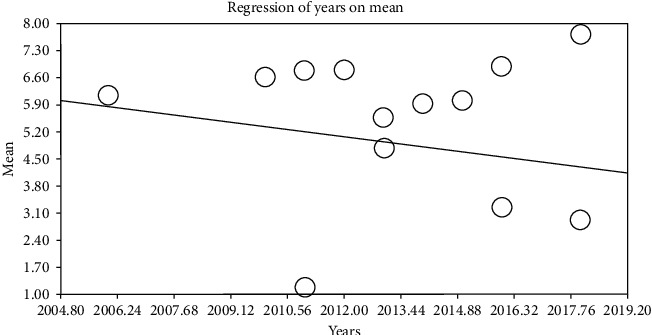
Metaregression of association between publication date and entered studies into the meta-analysis by using total mean index (intervention).
Figure 9.
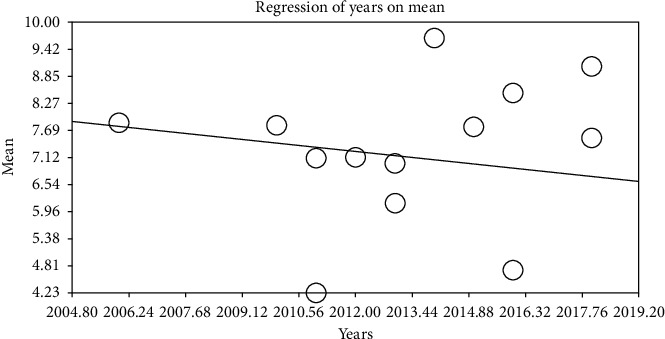
Metaregression of association between publication date and entered studies into the meta-analysis by using total mean index (control).
4. Discussion
Since labor is a stressful stage for pregnant individual, catecholamines and cortisol are released in response to pain and anxiety during labor, and by causing severe muscular contraction, this results in uterus muscle hypoxia, and in fact by interfering the labor process, this also causes reduction in energy and increases in mother's fatigue, and by the way it increases the length of labor time [36].
Therefore, this study aimed to determine the effect of lavender on reduction of labor pain in Iran by using meta-analysis. The results of the current study showed a significant difference through investigation of difference between mean scores of labor pain in intervention and control groups.
Estimated total mean in intervention group and control group was 5.4 ± 0.58 and 7.2 ± 0.42, respectively. In confirmation of this finding, Lamadah and Nomani [37] by studying the effect of massage aromatherapy by using lavender oil in regard to the level of pain and anxiety during labor among primiparous women in Egypt (38) and Bronze et al. by studying the effect of aromatherapy on labor outcome in England [38] found results similar to ours.
Studies by Kim et al. investigated the analgesic effects of lavender; the patients underwent breast biopsy by combination of oxygen and lavender supplement 2% which was administered to them by mask, the severity of pain 30 and 60 minutes after the surgery was not less than control group in comparison with patients administered oxygen without lavender, and the requests of patients with lavender group for receiving narcotic analgesic were not less than control group, and therefore the patients showed more satisfaction on pain self-management than control group [39].
In a study using aromatherapy by midwives during labor on 8058 mothers showed that using lavender reduces fear and anxiety of mothers and reduces using epidural anesthesia in this group [38].
The studies showed that lavender aroma is used as a medicinal herb effective in reducing anxiety and pain in mothers during labor, and there is a significant association between reduction in cortisol level and anxiety level [16].
Cortisol is the most important stress hormone [7]. The studies showed that lavender aroma causes reduction in serum cortisol level and subsequently reduction in anxiety and increase in woman's ability for adoption with labor and also reinforcement of narcotic effects and subsequently reduction in narcotic requirement [16].
The probable mechanism of oily essence of lavender is the effect on postsynaptic receptors which is mediated by CAMP and has not any effect on atropine-like receptors [40]. Linalool in lavender causes inhibition of releasing of acetylcholine and changing of ionic channel function in the region of neuromuscular connection and due to that linalyl acetate exhibits narcotic function, and linalool also performs as a sedative; this indicates the use of this herb as a traditional analgesic, and since massage facilitates absorption of volatile oil by skin, linalool and linalyl acetate are rapidly absorbed by skin massage (during 5 minutes), and its plasma concentration reaches the maximum after 19 minutes and disappears in 90 minutes [41, 42].
In aromatherapy, the most important sensations are affected through touch and smell, and while aromatic herbal essences are inhaled, smell impulses are transferred through olfactory receptors to the brain and results in stimulation of limbic system, which subsequently leads to mood moderation, awareness of emotion, maintenance of body temperature, reduction in anxiety and inducing peace emotion, and absorption by skin [43].
According to the obtained results from studies and results from current study, it can be concluded that lavender aroma affects hypothalamus and reduction in secretion of stimulatory hormone of corticotrophin by it through stimulation of olfactory pathways.
Subsequently, the release of adrenocorticotrophin by pituitary gland decreases, and this causes reduction in cortisol secretion by adrenal gland [16, 44].
However, aromatherapy mechanism may be through activation of peripheral neural receptors, which causes reduction in anxiety and fear of mother, and subsequently causes increase in endorphin secretion, pain reduction, catecholamine secretion reduction, and increase of effective uterine contractions induced by reduction in catecholamines and leads to reduction in labor duration [45, 46].
Reduction in labor pain leads to decrease in fatigue and increase in cooperation during labor resulted from the energy reservoir of mother in the second stage of labor and labor process acceleration.
It should be noted that this point is the researcher's perception of scientific texts and its accurate mechanism is not obvious.
One of the limitations in articles was a lack of blinding which is due to the nature of aromatherapy and massage therapy.
Given the results of the current study, to decrease the growing trend of cesarean section which is mainly due to fear of prolongation and the pain of vaginal delivery, aromatherapy and massage with lavender can be helpful, and this method should be involved in educational programs of midwifery and nursing students, and also in the training classes of pregnancy performed for clients and their attendants, this method can be educated to them. Further studies are warranted in regard to safety and quality of specific oils on various patients.
5. Conclusion
The high satisfaction resulted from aromatherapy in participants of this study, and the observed significant difference in pain score of intervention group indicates high efficiency of aromatherapy by inhaling lavender essence aroma. Therefore, it is essential to reduce unnecessary cesarean section and treatment costs and promote the health of mothers and infants by making a positive viewpoint through correct announcement to individuals and presentation of positive outcomes by introducing the nonpharmaceutical analgesic methods such as aromatherapy.
Acknowledgments
This study is the result of the research project with no. 3009124 approved by the Student Research Committee of Kermanshah University of Medical Sciences. The authors We hereby express their gratitude and appreciation to the respected authorities of that center for bearing the financial costs of this study: By the Student Research Committee of Kermanshah University of Medical Sciences and, Deputy for Research and Technology, Kermanshah University of Medical Sciences (IR) (3009124).
Abbreviations
- MESH:
Medical subject headings
- ISI:
Web of Science
- PRISMA:
Preferred Reporting Items for Systematic Reviews and Meta-Analyses.
Data Availability
Datasets are available through the corresponding author upon reasonable request.
Conflicts of Interest
The authors declare that they have no conflicts of interest regarding the publication of this paper.
Authors' Contributions
MK, NS, and AA contributed to the design. MM and RJ conducted statistical analysis and, participated in most of the study steps. SHSH and AVR prepared the manuscript. NS and AD assisted in designing the study and helped in the interpretation of the study. All authors have read and approved the content of the manuscript.
References
- 1.Chez R. A., Jonas W. B. The challenge of complementary and alternative medicine. American Journal of Obstetrics and Gynecology. 1997;177(5):1156–1161. doi: 10.1016/s0002-9378(97)70033-4. [DOI] [PubMed] [Google Scholar]
- 2.Vakilian K., Karamat A., Mousavi A., Shariati M., Ajami E., Atarha M. The effect of Lavender essence via inhalation method on labor pain. Journal of Shahrekord University of Medical Sciences. 2012;14(1):34–40. [Google Scholar]
- 3.Imura M., Misao H., Ushijima H. The psychological effects of aromatherapy-massage in healthy postpartum mothers. Journal of Midwifery & Women's Health. 2006;51(2):e21–e27. doi: 10.1016/j.jmwh.2005.08.009. [DOI] [PubMed] [Google Scholar]
- 4.Simkin P., Bolding A. Update on nonpharmacologic approaches to relieve labor pain and prevent suffering. Journal of Midwifery & Women’s Health. 2004;49(6):489–504. doi: 10.1016/s1526-9523(04)00355-1. [DOI] [PubMed] [Google Scholar]
- 5.Cooke B., Ernst E. Aromatherapy: a systematic review. The British Journal of General Practice: The Journal of the Royal College of General Practitioners. 2000;50(455):493–496. [PMC free article] [PubMed] [Google Scholar]
- 6.Buckle J. Aromatherapy in perianesthesia nursing. Journal of Perianesthesia Nursing. 1999;14(6):336–344. doi: 10.1016/s1089-9472(99)80094-x. [DOI] [PubMed] [Google Scholar]
- 7.Peer J. M., Spinhoven P., Roelofs K. Psychophysiological evidence for cortisol-induced reduction in early bias for implicit social threat in social phobia. Psychoneuroendocrinology. 2010;35(1):21–32. doi: 10.1016/j.psyneuen.2009.09.012. [DOI] [PubMed] [Google Scholar]
- 8.Ezzo J. What can be learned from Cochrane systematic reviews of massage that can guide future research. The Journal of Alternative and Complementary Medicine. 2007;13(2):291–296. doi: 10.1089/acm.2006.6291. [DOI] [PubMed] [Google Scholar]
- 9.Ganji F. Effect of a participatory intervention to reduce the number of unnecessary cesarean sections performed in shahrekord of Iran. Journal of Medical Science. 2006;6:690–692. doi: 10.3923/jms.2006.690.692. [DOI] [Google Scholar]
- 10.Tadayon P., Karimi F. Comparison of diclofenac with pethidine on the pain after cesarean section. International Journal of Pharmacology. 2007;3(2):201–203. doi: 10.3923/ijp.2007.201.203. [DOI] [Google Scholar]
- 11.Declercq E., Barger M., Cabral H. J., et al. Maternal outcomes associated with planned primary cesarean births compared with planned vaginal births. Obstetrics & Gynecology. 2007;109(3):669–677. doi: 10.1097/01.aog.0000255668.20639.40. [DOI] [PubMed] [Google Scholar]
- 12.Allaire A. D. Complementary and alternative medicine in the labor and delivery suite. Clinical Obstetrics and Gynecology. 2001;44(4):681–691. doi: 10.1097/00003081-200112000-00008. [DOI] [PubMed] [Google Scholar]
- 13.Tournaire M., Theau-Yonneau A. Complementary and alternative approaches to pain relief during labor. Evidence-based Complementary and Alternative Medicine. 2007;4(4):409–417. doi: 10.1093/ecam/nem012. [DOI] [PMC free article] [PubMed] [Google Scholar]
- 14.Eriksen M. Ronnie Falcao, Licensed Midwife Holistic Midwifery Care for Mother and Baby. California: Ronnie Falcao, LM MS CPM; 1994. Aromatherapy for childbearing. http://www.Gentlebirth.org/archives/%20aromathr.html. [Google Scholar]
- 15.Jahdi F., Sheikhan F., Merghati E., Haghani H. Effect of lavender essential on preneal pain after episiotomy. Journal of Sabzevar University of Medical Sciences. 2009;16:127–130. [Google Scholar]
- 16.Mirzaei F., Keshtgar S., Kaviani M., Rajaeifard A. The effect of lavender essence smelling during labor on cortisol and serotonin plasma levels and anxiety reduction in nulliparous women. Journal of Kerman University of Medical Sciences. 2015;16(3):245–254. [Google Scholar]
- 17.Buchbauer G., Jirovetz L., Jäger W., Plank C., Dietrich H. Fragrance compounds and essential oils with sedative effects upon inhalation. Journal of Pharmaceutical Sciences. 1993;82(6):660–664. doi: 10.1002/jps.2600820623. [DOI] [PubMed] [Google Scholar]
- 18.Ghelardini C., Galeotti N., Salvatore G., Mazzanti G. Local anaesthetic activity of the essential oil of Lavandula angustifolia. Planta Medica. 1999;65(8):700–703. doi: 10.1055/s-1999-14045. [DOI] [PubMed] [Google Scholar]
- 19.Duke J. A. The Green Pharmacy: New Discoveries in Herbal Remedies for Common Diseases and Conditions from the World's Foremost Authority on Healing Herbs. Kutztown, Pennsylvania, PA, USA: Rodale Press; 1997. p. p. 507. [Google Scholar]
- 20.Starck M. Handbook of Natural Therapies: Exploring the Spiral of Healing. Berkeley, CA, USA: Crossing Press; 1998. p. p. 172. [Google Scholar]
- 21.Hosseini S., Bagheri M., Honarparvaran N. Investigating the effect of music on labor pain and progress in the active stage of first labor. European Review for Medical and Pharmacological Sciences. 2013;17(11):1479–1487. [PubMed] [Google Scholar]
- 22.Schulz K. F., Altman D. G., Moher D. CONSORT 2010 statement: updated guidelines for reporting parallel group randomised trials. BioMed Central Medicine. 2010;8(1):p. 18. doi: 10.1186/1741-7015-8-18. [DOI] [PMC free article] [PubMed] [Google Scholar]
- 23.Vakilian K., Keramat A., Mousavi A., Shariati M., Ajami M. E., Atarha M. The effect of lavender essential oil by inhalation method on labor pain. Journal of Shahrekord University of Medical Sciences. 2012;14(1):34–40. in Persian. [Google Scholar]
- 24.Alavi N., Nemati M., Kaviani M., Tabaei M. H. Effect of lavender aroma on perception of pain and delivery outcome in primiparous women. Armaghane Danesh Journal. 2014;15(1):31–37. doi: 10.12968/bjom.2014.22.2.125. in Persian. [DOI] [Google Scholar]
- 25.Seraji A., Vakilian K. Comparison of the effect of aromatherapy with lavender and respiratory technique on labor pain relief. Complementary Medicine. 2011;1:34–41. in Persian. [Google Scholar]
- 26.Leghaei S., Hosseini A. E. Comparison the effect of massage therapy with lavender and almond oil on duration and pain of labor and serum beta-endorphins in primiparous women. Journal of Animal Physiology and Development. 2018;12:81–89. in Persian. [Google Scholar]
- 27.Hosseini S. E., Keramaty F., Naeiny K. S. A comparative study of massage with lavender (Lavandula) essential oil and almond oil on pain relief after cesarean operation in primiparous women. Medical Journal of Tabriz University Of Medical Sciences. 2016;38(2):22–27. [Google Scholar]
- 28.Nikbakht S., Davodi D., Hamidian Z., Dizavandi D., Norian R., Tofighi R. The effect of lavender aroma inhalation on severity of labor pain in primiparous women. Mashhad University of Medical Sciences Journal. 2014;1:81–95. in Persian. [Google Scholar]
- 29.Nehbandanii Z., Rezayee Kahkha Galeh M., Bordbari M., Koochakzai M. Comparison the effects of aromatherapy with rose extract and lavender on the pain of the active phase of labor in primipara women. Scientific Journal of Kurdistan University of Medical Sciences. 2018;23(5):45–54. [Google Scholar]
- 30.Sobhani A. R., Sharemi H., Orang R. The effect of essential of lavender on cesarean pain. Guilan University of Medical Sciences. 2006;62(16):80–86. in Persian. [Google Scholar]
- 31.Khani L., Birjandi S., Mohammad Khani H. The effect of lavender aromatherapy on decreasing duration of first and second stage of labor in primiparous women. Hormozgan Medical Journal. 2013;17(2):145–154. in Persian. [Google Scholar]
- 32.Houshyar A. E., Rezaie H. H., Jahani Y., Kazemi M., Monfared S. Comparison of two methods of aromatherapy with lavender essence and transcutaneous electrical nerve stimulation (TENS) on cesarean postoperative pain. Iranian Journal of Obstetrics, Gynecology and Infertility. 2015;18(146):6–12. [Google Scholar]
- 33.Hadi N., Hanid A. A. Lavender essence for post-cesarean pain. Pakistan Journal of Biological Sciences. 2011;14(11):p. 664. doi: 10.3923/pjbs.2011.664.667. [DOI] [PubMed] [Google Scholar]
- 34.Yazdkhasti M., Pirak A. The effect of aromatherapy with lavender essence on severity of labor pain and duration of labor in primiparous women. Complementary Therapies in Clinical Practice. 2016;25:81–86. doi: 10.1016/j.ctcp.2016.08.008. [DOI] [PubMed] [Google Scholar]
- 35.Olapour A., Behaeen K., Akhondzadeh R., Soltani F., al Sadat Razavi F., Bekhradi R. The effect of inhalation of aromatherapy blend containing lavender essential oil on cesarean postoperative pain. Anesthesiology and Pain Medicine. 2013;3(1):203–207. doi: 10.5812/aapm.9570. [DOI] [PMC free article] [PubMed] [Google Scholar]
- 36.Torke Zahrani S. H., Honargoo M., Jannesari S. H., Alavi H. Study effect of massage on the intensity pain during first stage of labor. Journal of the Shahead Beheshti University of Medical Sciences and Health Services. 2008;2:141–145. in Persian. [Google Scholar]
- 37.Lamadah S. M., Nomani I. The effect of aromatherapy massage using lavender oil on the level of pain and anxiety during labour among primigravida women. American Journal of Nursing Science. 2016;5(2):37–44. [Google Scholar]
- 38.Burns E., Zobbi V., Panzeri D., Oskrochi R., Regalia A. Aromatherapy in childbirth: a pilot randomised controlled trial. Royal College of Obstetricians and Gynaecologists: An International Journal of Obstetrics & Gynaecology. 2007;114(7):838–844. doi: 10.1111/j.1471-0528.2007.01381.x. [DOI] [PubMed] [Google Scholar]
- 39.Kim J. T., Wajda M., Cuff G., et al. Evaluation of aromatherapy in treating postoperative pain: pilot study. Pain Practice. 2006;6(4):273–277. doi: 10.1111/j.1533-2500.2006.00095.x. [DOI] [PubMed] [Google Scholar]
- 40.Efferth T., Greten H. Medicinal and aromatic plant research in the 21st century. Medicinal and Aromatic Plants. 2012;1(2):p. e110. doi: 10.4172/2167-0412.1000e110. [DOI] [Google Scholar]
- 41.Re L., Barocci S., Sonnino S., et al. Linalool modifies the nicotinic receptor-ion channel kinetics at the mouse neuromuscular junction. Pharmacological Research. 2000;42(2):177–181. doi: 10.1006/phrs.2000.0671. [DOI] [PubMed] [Google Scholar]
- 42.Linck V. d. M., da Silva A. L., Figueiró M., et al. Inhaled linalool-induced sedation in mice. Phytomedicine. 2009;16(4):303–307. doi: 10.1016/j.phymed.2008.08.001. [DOI] [PubMed] [Google Scholar]
- 43.Attarha M., Vakillian K., Rozbahany N., Bekhradi R. Effect of perineal massage with lavender essence on episiotomy and laceration. Journal of Babol University of Medical Sciences. 2009;11:25–30. in Persian. [Google Scholar]
- 44.Babashahi M., Fayazi S., Aghel N., Haghighizadeh M. H. Effect of aromatherapy on anxiety level among preoperative patients. Scientefic Medical Journal of Ahvaz University of Medical Sciences. 2010;9:507–516. in Persian. [Google Scholar]
- 45.Lowdermilk D., Perry S., Cashion K. Maternity Nursing. Maryland Heights, MO, USA: Mosby; 2003. pp. 778–788. [Google Scholar]
- 46.Mortazavi F., Rakhshani M. H. The effect of atropine, hyoscine and prometazine on the duration of stages and rate of women. Journal of Gorgan University of Medical Sciences. 2004;6:92–96. in Persian. [Google Scholar]
Associated Data
This section collects any data citations, data availability statements, or supplementary materials included in this article.
Data Availability Statement
Datasets are available through the corresponding author upon reasonable request.


